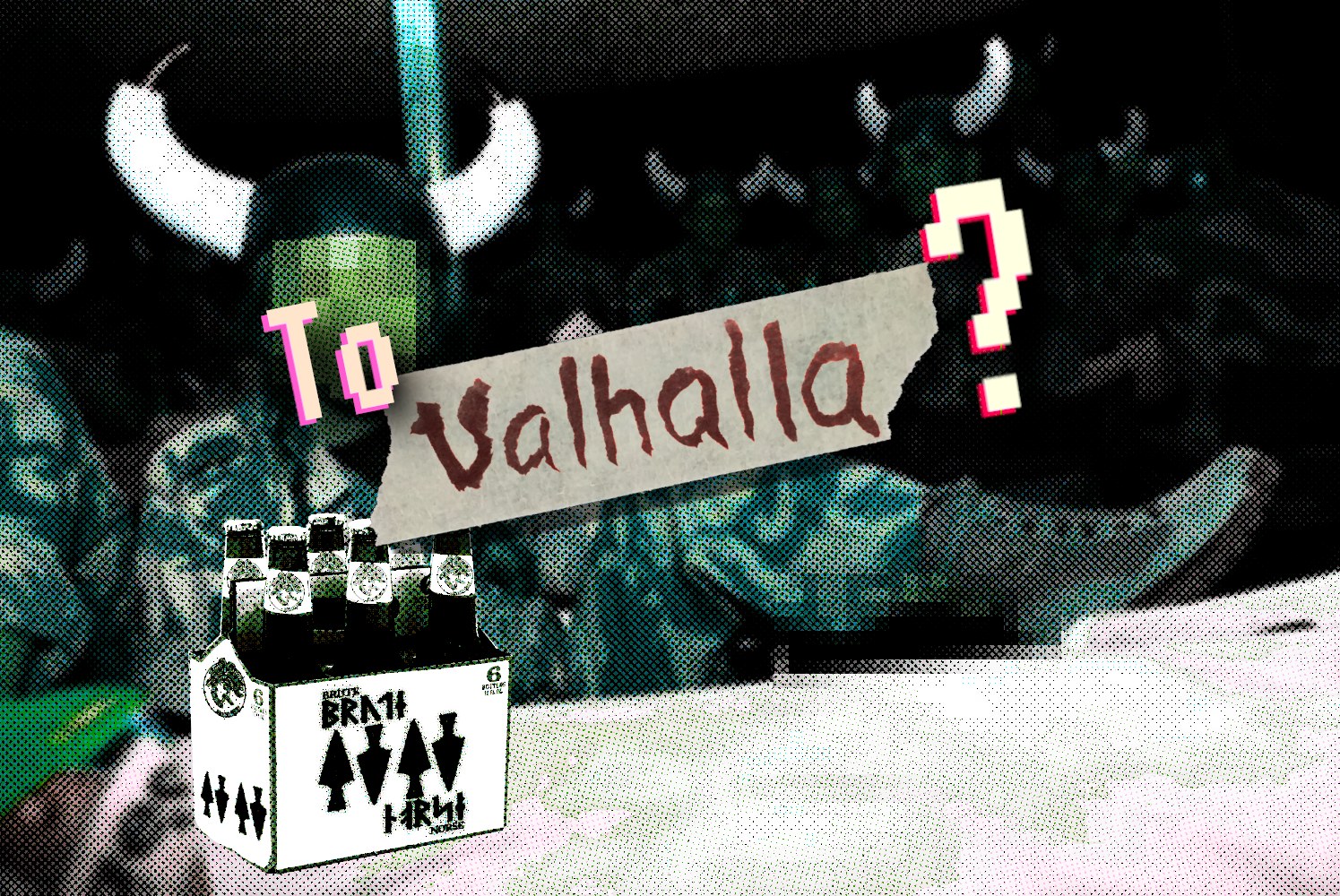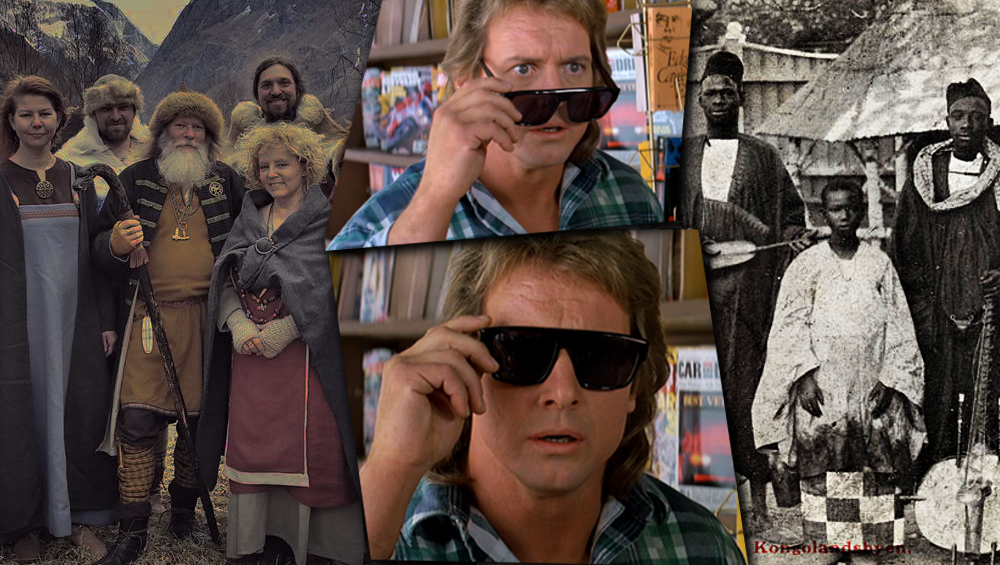It was a regular humid Saturday morning here in New Jorvik, USA, when I opened my browser hoping for news of the old country, so that just for a minute or two I could forget the dismal stank of the big city. Scrolling through my feed, I was swept to the edge of my seat at the sight of a letter to the Norwegian newspaper Klassekampen from the day before. It seemed to be a merciless slaughter of the newly erected "viking village" of Vikingvalley - Njardarheimr in Gudvangen, on the beautiful banks of Nærøyfjorden, incidently a UNESCO world heritage site (the landscape, not the village).
I leaned over to light a smoke from the perpetually burning miniature raven banner that stands on my desk and got to reading. The scathing critique was penned by a certain Aud Farstad, an author, and apparently some kind of healthcare historian. Below the subheading "Why do they want to present a ficticious Viking Age at the world heritage site?" the main title "Viking-Kitsch" beamed at my eyes, illustrated by an outdoor barbeque and a wooden statue of Georg Hansen standing at the prow of a viking ship. The visionary, the dear leader if you will, to Gudvangen's banana republic. As I went on I could hardly believe what I was reading. Lest it be unsaid: Farstad isn't pulling any punches. Like a reboot of Carpenter's They Live set to a Viking backdrop, she's donned her magic kitsch-ray glasses and revealed the sinister agenda hidden beneath the dragon heads. All out of bubblegum to chew, she proceeds to kick ass.
CONSUME
In her smörgåsbord of complaints, Farstad begins by alluding to the ongoing discussion of negative consequences of mass tourism in Norway. This ruse keeps the reader's attention long enough for her to slip us the real reason behind her letter: Let us for a minute, avert our eyes from the cruise lines lining their pockets with fjord murder, and take a look at what we are offering them by means of representation, she implores. She recently went to Gudvangen and was shocked by what she saw, she says. The UNESCO heritage badge is a confirmation that what we have in the fjords, and sites like Gudvangen in particular, is not only unique but fragile. Culturally and naturally distinct as this region is, it would be hard to disagree. Her critique directly attacks Njardarheimr's own illusion of authenticity which consists, according to her, of false representations, pseudo-historical architecture, and bizarre sales tactics consisting of attaching the prefix "viking" to everything. "Enjoy yourselves on the viking lawn!" as one caption hilariously reads. This mockery of history and our heritage reads almost like some sort of financial conspiracy with the tourist industry against the heritage site, she seems to claim, while also selling the tourists short with false representation.
All fair game if you ask me. But it doesn't take long before the letter takes a turn towards the counter-productively absurd. Much like the verbal scorn exibited by humiliated saga housewives, Farstad goes way overboard with her critique of Viking Age representation by staking the claim that the Viking Age possibly never actually existed(!). Citing some ghostlike and unnamed "historians", her complaint about "Viking activities", "Viking food" and so on, is not problematic just for the sake of obvious authenticity issues, but for the fact that "Viking food never existed". According to what seems to be be her line of reasoning, a "Viking hot dog" becomes a non-entity, not just because the so-called Vikings didn't eat hot dogs, but because there were no Vikings to eat hot dogs (!?). Is she being sincere? It is difficult to recognize her Viking Age revisionism in any history book I ever read. She is either splitting hairs on a subatomic level, a post-ironic genius, or she is insane. This is Poe's law in action.
They could haul a 10th century longhouse through a rift in time and space, and it wouldn't make a difference to Farstad, who claims she wouldn't mind such a circus anywhere else but the UNESCO site. She takes personal offense by the need to speak English in a nearby Hotel's souvenir shop, and is enraged by the fact that the menu of its attached restaurant is written in Bokmål, in the heartland of the Nynorsk norm of written Norwegian. Bokmål, as all Nynorsk writing Norwegians know, is the language of the enemy. The language of the regime.
She takes it as a personal insult that she, a red blooded Fjordwegian, whose ancestral blood saturates the land's vertical soils, for which the fathers fought and mothers wept, is subjected to this "Congo Village for West Norwegians". A term that recalls the controversial Congo Village displayed in the "amusement section" of the 1914 World Fair in Oslo, where people gawked at a staged ethnographic display of authentic negros doing authentic negro things (though presented as a Congo Village, the bulk of the participants were West African). A human menagerie of sorts. To stretch this analogy even further, she suspects that the "vikings" of Njardarheimr aren't even Norwegian, but - hold your breath - Eastern Europeans. " "Vikings" ", as she says in quotation marks. If she had paid to enter she might have found out, but apparently she refuses to do so.
Admitedly, some of Farstad's critics don't seem bright enough to get the point she is trying to make with the curious Congo Village analogy, which is by far the most original part of the text. Most obviously, I think she is trying to say that both are morbid displays that inspire no authentic respect for its apparent subject matter. It is only her clumsy delivery that leads denser readers to think she was assaulting African tribal culture as a whole, as if the mere act of being reminded of an embarrassing 104 year old ethnographic display is antithetical to current year discourse. That being said, Farstad's neurotic stance towards ethnography and cultural heritage is not without precedence. Rather, it finds itself in a fine tradition of inner struggles of the Norwegian self-image, constantly wrestling between chronophobic self-loathing and national pride, best exemplified by one time minister of justice Johan Castberg on the subject of Norwegian contributions to the World Fair in Paris, which I've translated below from the 1888 proceedings of the Norwegian Parliament:












